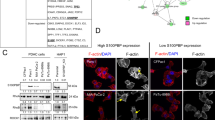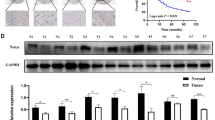Abstract
p73 is a member of the p53 protein family. Although the tumor suppressor function of p53 is clearly defined, the role of p73 in tumorigenesis is still a matter of debate. A complex pattern of expression of p73 isoforms makes it difficult to unambiguously interpret the experimental results. Previously, we along with others have found that the N-terminally truncated isoform of p73, ΔNp73, has potent anti-apoptotic and oncogenic properties in vitro and in vivo. In this study, we analyzed, for the first time, the regulation of ΔNp73 in a large number of gastric, gastroesophageal junction and esophageal tumors. We found that expression of ΔNp73 mRNA and protein is increased in these neoplasms. Furthermore, the upregulation of the ΔNp73 protein is significantly associated with poor patient survival. Oncogenic properties of ΔNp73 were further confirmed by finding that ΔNp73 facilitates anchorage-independent growth of gastric epithelial cells in soft agar. As little is currently known about the regulation of ΔNp73 transcription, we investigated the alternative p73 gene promoter that mediates the ΔNp73 expression. Analyzing the ΔNp73 promoter in silico as well as by using chromatin immunoprecipitation, site-directed mutagenesis and deletion analyses, we identified the evolutionary conserved region within the ΔNp73 promoter that contains binding sites for HIC1 (hypermethylated in cancer) protein. We found that HIC1 negatively regulates ΔNp73 transcription in mucosal epithelial cells. This leads to a decrease in ΔNp73 protein levels and may normally control the oncogenic potential of the ΔNp73 isoform.
This is a preview of subscription content, access via your institution
Access options
Subscribe to this journal
Receive 50 print issues and online access
$259.00 per year
only $5.18 per issue
Buy this article
- Purchase on Springer Link
- Instant access to full article PDF
Prices may be subject to local taxes which are calculated during checkout




Similar content being viewed by others
References
Buhlmann S, Putzer BM . (2008). DNp73 a matter of cancer: mechanisms and clinical implications. Biochim Biophys Acta 1785: 207–216.
Cam H, Griesmann H, Beitzinger M, Hofmann L, Beinoraviciute-Kellner R, Sauer M et al. (2006). p53 family members in myogenic differentiation and rhabdomyosarcoma development. Cancer Cell 10: 281–293.
Cartharius K, Frech K, Grote K, Klocke B, Haltmeier M, Klingenhoff A et al. (2005). MatInspector and beyond: promoter analysis based on transcription factor binding sites. Bioinformatics 21: 2933–2942.
Casciano I, Mazzocco K, Boni L, Pagnan G, Banelli B, Allemanni G et al. (2002). Expression of DeltaNp73 is a molecular marker for adverse outcome in neuroblastoma patients. Cell Death Differ 9: 246–251.
Chen WY, Baylin SB . (2005). Inactivation of tumor suppressor genes: choice between genetic and epigenetic routes. Cell Cycle 4: 10–12.
Grob TJ, Novak U, Maisse C, Barcaroli D, Luthi AU, Pirnia F et al. (2001). Human delta Np73 regulates a dominant negative feedback loop for TAp73 and p53. Cell Death Differ 8: 1213–1223.
Kanai Y, Ushijima S, Ochiai A, Eguchi K, Hui A, Hirohashi S . (1998). DNA hypermethylation at the D17S5 locus is associated with gastric carcinogenesis. Cancer Lett 122: 135–141.
Kartasheva NN, Contente A, Lenz-Stoppler C, Roth J, Dobbelstein M . (2002). p53 induces the expression of its antagonist p73 Delta N, establishing an autoregulatory feedback loop. Oncogene 21: 4715–4727.
Lin KW, Nam SY, Toh WH, Dulloo I, Sabapathy K . (2004). Multiple stress signals induce p73beta accumulation. Neoplasia 6: 546–557.
Loots GG, Ovcharenko I . (2004). rVISTA 2.0: evolutionary analysis of transcription factor binding sites. Nucleic Acids Res 32: W217–W221.
Melino G, Lu X, Gasco M, Crook T, Knight RA . (2003). Functional regulation of p73 and p63: development and cancer. Trends Biochem Sci 28: 663–670.
Nakagawa T, Takahashi M, Ozaki T, Watanabe Ki K, Todo S, Mizuguchi H et al. (2002). Autoinhibitory regulation of p73 by Delta Np73 to modulate cell survival and death through a p73-specific target element within the Delta Np73 promoter. Mol Cell Biol 22: 2575–2585.
Petrenko O, Zaika A, Moll UM . (2003). deltaNp73 facilitates cell immortalization and cooperates with oncogenic Ras in cellular transformation in vivo. Mol Cell Biol 23: 5540–5555.
Stiewe T, Tuve S, Peter M, Tannapfel A, Elmaagacli AH, Putzer BM . (2004). Quantitative TP73 transcript analysis in hepatocellular carcinomas. Clin Cancer Res 10: 626–633.
Tannapfel A, John K, Mise N, Schmidt A, Buhlmann S, Ibrahim SM et al. (2008). Autonomous growth and hepatocarcinogenesis in transgenic mice expressing the p53 family inhibitor DNp73. Carcinogenesis 29: 211–218.
Tomasini R, Tsuchihara K, Wilhelm M, Fujitani M, Rufini A, Cheung CC et al. (2008). TAp73 knockout shows genomic instability with infertility and tumor suppressor functions. Genes Dev 22: 2677–2691.
Vilgelm A, El-Rifai W, Zaika A . (2008a). Therapeutic prospects for p73 and p63: rising from the shadow of p53. Drug Resist Updat 11: 152–163.
Vilgelm A, Wei JX, Piazuelo MB, Washington MK, Prassolov V, El-Rifai W et al. (2008b). DeltaNp73alpha regulates MDR1 expression by inhibiting p53 function. Oncogene 27: 2170–2176.
Wales MM, Biel MA, el Deiry W, Nelkin BD, Issa JP, Cavenee WK et al. (1995). p53 activates expression of HIC-1, a new candidate tumour suppressor gene on 17p13.3. Nat Med 1: 570–577.
Wang F, Hansen RK, Radisky D, Yoneda T, Barcellos-Hoff MH, Petersen OW et al. (2002). Phenotypic reversion or death of cancer cells by altering signaling pathways in three-dimensional contexts. J Natl Cancer Inst 94: 1494–1503.
Zaika AI, El-Rifai W . (2006). The role of p53 protein family in gastrointestinal malignancies. Cell Death Differ 13: 935–940.
Acknowledgements
This work was supported by the National Cancer Institute grant NIH CA108956 and Vanderbilt CTSA grant UL1 RR024975. We thank Dr Castells and Dr Pera of University of Barcelona for their assistance.
Author information
Authors and Affiliations
Corresponding author
Ethics declarations
Competing interests
The authors declare no conflict of interest.
Additional information
Supplementary Information accompanies the paper on the Oncogene website
Rights and permissions
About this article
Cite this article
Vilgelm, A., Hong, SM., Washington, M. et al. Characterization of ΔNp73 expression and regulation in gastric and esophageal tumors. Oncogene 29, 5861–5868 (2010). https://doi.org/10.1038/onc.2010.319
Received:
Revised:
Accepted:
Published:
Issue Date:
DOI: https://doi.org/10.1038/onc.2010.319
Keywords
This article is cited by
-
The p53 family member p73 in the regulation of cell stress response
Biology Direct (2021)
-
Impact of RUNX2 on drug-resistant human pancreatic cancer cells with p53 mutations
BMC Cancer (2018)
-
Clinical implications of the deregulated TP73 isoforms expression in cancer
Clinical and Translational Oncology (2018)
-
A balancing act: orchestrating amino-truncated and full-length p73 variants as decisive factors in cancer progression
Oncogene (2015)
-
Δ133p53 is an independent prognostic marker in p53 mutant advanced serous ovarian cancer
British Journal of Cancer (2011)



